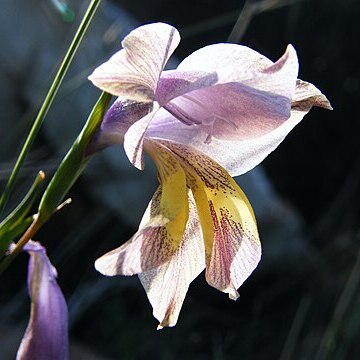Plants 200-500(-1000) mm high, with cataphylls purple mottled with white. Corm globose, 12-18 mm diam.; tunics leathery to ± woody, fragmenting into narrow strips or coarse fibres. Stem erect below, flexed outward above sheaths of 2 upper leaves, unbranched. Leaves 3, lowermost usually shortly exceeding spike, linear, (1-)3-9 mm wide, main vein lightly to moderately thickened, margins not or very little thickened, second leaf sheathing lower 1/2 of stem, channelled or with short blade, uppermost leaf inserted on upper 1/3 of stem, margins united below. Spike inclined, lightly flexuose, (1)4-to 6(10)-flowered; bracts pale green or greyish or flushed with purple, veins and margins translucent, outer 25-35(-65) mm long, inner shorter, lightly notched apically. Flowers pale to mid-blue to grey or pale yellow, rarely purple or pink, lower tepals with yellow band across upper third or yellow in lower 2/3, sometimes also streaked below and above with dark purple to blue, usually intensely scented of freesias or violets; perianth tube obliquely funnel-shaped, 13-16 mm long, lower cylindric part 5-7 mm long; tepals ovate to lanceolate, dorsal largest, arching forward, recurved apically, 24-30(-38) x (11-)17-20(-26) mm, upper laterals ± equal or slightly smaller, 22-34 x 14-18 mm, curving outward distally, lower 3 tepals joined to upper laterals for up to 5 mm and together for 4-6 mm, 18-25 x 7-13 mm, widest in upper 1/3, laterals deeply channelled below with margins ± vertical. Filaments 11-15 mm long, exserted 5-6 mm from tube; anthers 8-10 mm long, cream-coloured; pollen cream-coloured. Style arching over stamens, dividing near anther apices, branches 3-4 mm long. Capsules oblong to ellipsoid, acute, 20-25 mm long. Seeds oblong, 6-8 x 5-7 mm, broadly and evenly winged.
More
Cormous geophyte, 300-600 mm tall, corm with fibrous tunics, stem base mottled. Leaves linear, midrib prominently and margins lightly thickened. Flowers few in an inclined spike, bilabiate, blue to dark violet (yellow, occasionally pink elsewhere), lower tepals marked with yellow, intensely fragrant.
Cormous geophyte, 30-60 cm, tunics fibrous, stem base mottled. Leaves linear, midrib prominent. Flowers bilabiate, blue to violet or yellow, occasionally pink, fragrant.

